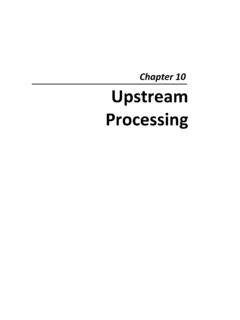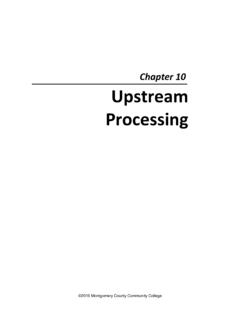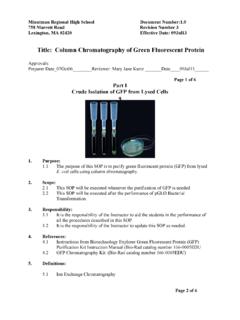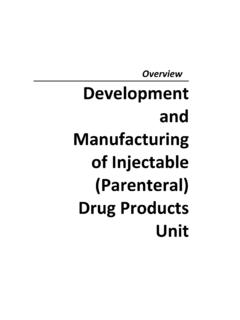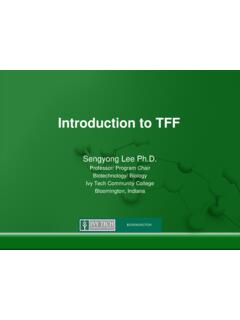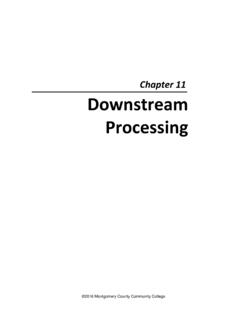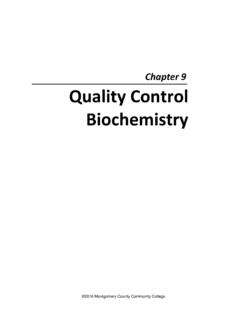Transcription of Chapter 15 Inspection, Labeling, and Packaging
1 2016 Montgomery County Community College Chapter 15 inspection , Labeling, and Packaging 2 Chapter 15 inspection , Labeling, and Packaging Objectives The final phases of drug product manufacturing consist of a physical inspection of the primary product container and the liquid or lyophilized drug product within the container. This is followed by labeling and Packaging the product for shipment. The inspection may be manual, semi-automated, or fully-automated. What is Packaging ? For parenteral drugs it consists of: the primary container: Packaging that is in direct contact with the drug product ( , vial, syringe, stopper, ampoule) secondary Packaging : Packaging that is designed to protect both the product and the primary container over the life of the drug product labeling: this is the label applied to either the primary container, printed cartons that the primary container is placed in, or package inserts All proposed Packaging must be proven to be appropriate for its intended use.
2 It must not only adequately protect the product but also be compatible with the product. Determining compatibility with primary Packaging components is an integral part of the dosage form development process. The Packaging components (glass, rubber stoppers, and various plastics) must be proven not to add or remove anything from the drug product. The specifics of product contact studies are covered in another part of this Chapter . After completing this Chapter the student will be able to: explain the purpose of inspection and some related regulatory requirements. describe some basic regulatory requirements and manufacturing controls related to labeling and explain why clear, accurate, and complete labeling is important. identify the difference between a label used for clinical trials versus a label used for commercial production.
3 Identify some basic types of Packaging used in the pharmaceutical industry. describe some basic regulatory requirements related to Packaging and explain how Packaging helps to prevent others from tampering with a company s product. Introduction to Biomanufacturing 3 Terms Acceptable Quality Limit (AQL): an inspection of components or filled vials/syringes to both determine the number and types of defects and evaluate them against a predetermined numerical value that represents the maximum number of each level of defect that can be found during QA inspection without impacting overall batch quality Adequate directions for use: directions under which the layman can use a drug both safely and for the purposes for which it is intended Clinical trials Open label trials: trials in which both researchers and participants are aware of which treatment is being administered; for these trials, vials and syringes can have labels that directly identify the compound and dosage.
4 Single blind trials: trials in which those administering the drug are aware of whether the treatment is active or placebo but the patient is unaware; the vials and syringes can be labeled with a code or lot number that makes it directly evident to the physician which compound is being administered. Double blind trials: both the administrators and the participants are unaware of which treatment is being administered; labeling strategies must be implemented so that the contents of the vial/syringe are not known by the physician administering the drug; however, later identification by the company conducting the trial is possible. Container closure system: refers to the sum of Packaging components that together contain and protect the dosage form; this includes both primary Packaging components and secondary Packaging components if the latter are intended to provide additional protection to the drug product; a Packaging system is equivalent to a container closure system.
5 inspection Automated inspection : fully automated inspection systems involve multiple camera systems for inspecting large numbers of product containers at a high rate of speed Manual inspection : an inspection of components or filled vials/syringes performed by an operator who picks up and exams items per predefined formal inspection procedures and AQL specifications; filled vials and syringes are usually examined in a light booth against both white and dark backgrounds. Semi-Automated inspection : a manual inspection combining inspection by personnel with an integrated conveyor and timing system Labeling: per 21 CFR 201(m) labeling is all labels and other written, printed, or graphic 1) upon any article or any of its containers or wrappers or 2) accompanying such article at any time while a device is held for sale after shipment or delivery for shipment in interstate commerce.
6 4 Chapter 15 inspection , Labeling, and Packaging Packaging (source: FDA Guidance for Industry: Container Closure Systems for Packaging Human Drugs and Biologics, May 1999 examples and images of types of Packaging are provided later in this Chapter ). Materials of construction: refers to the substances ( , glass, high density polyethylene [HDPE] resin, metal) used to manufacture a Packaging component. Packaging component: any single part of a container closure system; typical components are containers ( , ampoules, vials, bottles), container liners ( , tube liners), closures ( , screw caps, stoppers), closure liners, stopper overseals, container inner seals, administration ports ( , on large-volume parenterals [LVPs]), overwraps, administration accessories, and container labels. Primary Packaging component: a Packaging component that either is or may be in direct contact with the dosage form Secondary Packaging component: a Packaging component that is not and will not be in direct contact with the dosage form Introduction to Biomanufacturing 5 inspection In addition to meeting chemical and microbiological specifications, parenteral products must be visually inspected for defined attributes.
7 Each container produced during a manufacturing run must be examined for both container defects and product defects. Defects are categorized based both on the likelihood of the defect being found in inspection and the potential impact of the defect if it is not discovered during the inspection process. Using these criteria, they are classified as critical, major and minor defects. Once trained manufacturing personnel have inspected the batch, Quality Assurance (QA) personnel perform an additional check. Based on batch size, a statistical sample is pulled and inspected by QA. This inspection is referred to as Acceptable Quality Limit (AQL). Each of the defect categories is assigned a numerical value that represents the maximum number of each level of defect that can be found during QA inspection without impacting overall batch quality.
8 The American National Standards Institute/American Society for Quality Control (ANSI/ASQC) , sampling Procedures and Tables for inspection by Attributes is the primary reference used for setting AQL levels. Table 15-1. Sample AQL table based on ANSI/ASQC, Batch Size Sample Size Allowable Critical Defects Allowable Major Defects Allowable Minor Defects 501-1,200 200 0 5 10 1,201-3,200 200 0 5 10 3,201-10,000 200 0 5 10 10,001-35,000 315 0 7 14 35,001-150,000 800 1 14 21 150,001-500,000 800 1 14 21 500,001 and over 1250 2 21 21 Manual inspection With manual inspection , an inspector physically picks up and examines the drug product containers. The manual inspection process employs the use of a lighted booth (Figure 15-1) with a back wall composed of non-glare material that is divided into two halves one black and one white.
9 The inspector picks up one or more containers, depending on the size, and examines the container(s) in the lighted booth once in front of the black background and once in front of the white background. Various defects will at times be more apparent when viewed against one color versus the other. 6 Chapter 15 inspection , Labeling, and Packaging Figure 15-1. pharmaceutical manual inspection booth (courtesy OEM-Optical) The amount of time each container or set of containers is inspected should be limited and defined within the inspection Standard Operating Procedure (SOP). Prolonged examination does not result in a better inspection ; it generally results in a high level of false rejects. Any containers having identified defects are rejected. Each defect is recorded in the appropriate category (critical, major, or minor), and at the end of the inspection the number of rejects is totaled.
10 Limits for each defect type or overall defect limits are individual to each manufacturer. Some have in-process limits that may trigger a tighter AQL (a larger sample set will be taken for the AQL inspection ). Others have limits for percentage of defects that may trigger an investigation if exceeded. In summary there is a mechanism in place to recognize and react to out-of-trend results that may impact product quality. Semi-automated inspection Semi-automated inspection is a manual inspection with an integrated conveyor and timing system. There are generally several booths linked together (Figure 15-2), and the vials are delivered to the inspectors by the conveyor. The vials travel down the conveyor and stop for the set inspection time. The inspector picks up the vials, performs the inspection in the lighted booth, and places the vials back onto the conveyer to proceed to traying off.
